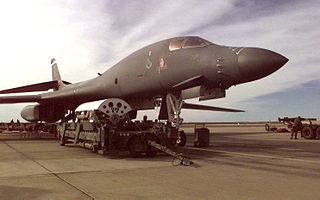
The 345th Bombardment Group is an inactive United States Air Force unit. Its last assignment was with the Tactical Air Command at Langley Air Force Base, Virginia, where it was inactivated on 25 June 1959.

The 70th Flying Training Squadron is reserve unit of the United States Air Force based at the United States Air Force Academy, Colorado.

The 2d Bombardment Squadron is an inactive United States Air Force unit. Its last assignment as a Boeing B-52 Stratofortress squadron was with the Strategic Air Command 22d Bombardment Wing stationed at March Air Force Base, California. It was inactivated on 1 October 1982. The unit was redesignated as the 2d Strategic Squadron as a Boeing KC-135 Stratotanker rotational squadron with the 306th Strategic Wing and was last active at RAF Mildenhall, England in 1992.

The 63d Bombardment Squadron is an inactive United States Air Force unit that was last assigned to the 43rd Bombardment Wing at Little Rock Air Force Base, Arkansas, where it was inactivated on 31 January 1970.

The 64th Bombardment Squadron is an inactive United States Air Force unit that was last assigned to the 43rd Bombardment Wing at Little Rock Air Force Base, Arkansas, where it was inactivated on 31 January 1970.

The 65th Special Operations Squadron is an Air Force Special Operations Command unit which flies the General Atomics MQ-9 Reaper at Hurlburt Field, Florida. The squadron was first activated as the 65th Bombardment Squadron in January 1941, one of the original squadrons of the 43rd Bombardment Group. Following the attack on Pearl Harbor, the squadron participated in antisubmarine patrols until January 1942, when it moved to Australia and the Southwest Pacific Theater. It moved forward with US forces through New Guinea and the Philippines, moving to Ie Shima shortly before V-J Day for operations against Japan. It earned two Distinguished Unit Citations and a Philippine Presidential Unit Citation for combat operations. During this period, a crew from the 65th became the most decorated aircrew in United States history, when their B-17 fought off twenty Japanese fighters during a photo reconnaissance mission. The squadron was inactivated in the Philippines in April 1946.

The 403d Bombardment Squadron is an inactive United States Air Force unit. It was last assigned to the 43rd Bombardment Wing at Carswell Air Force Base, Texas, where it was inactivated on 1 January 1961.

The 498th Bombardment Squadron is an inactive United States Air Force unit. It was last assigned to the 345th Bombardment Wing at Langley Air Force Base, Virginia, where it was inactivated on 25 June 1959.

The 499th Bombardment Squadron is an inactive United States Air Force unit. It was last assigned to the 345th Bombardment Wing at Langley Air Force Base, Virginia, where it was inactivated on 25 June 1959.

The 501st Bombardment Squadron is an inactive United States Air Force unit. It was last assigned to the 345th Bombardment Wing at Langley Air Force Base, Virginia, where it was inactivated on 25 June 1959.

The 819th Bombardment Squadron is an inactive United States Air Force unit. Its last assignment was with the 30th Bombardment Group at Kahuku Army Air Field, Hawaii, where it was inactivated on 30 November 1945.

The squadron was organized in March 1942 as the 380th Bombardment Squadron and trained in the Southeastern United States with North American B-25 Mitchells. In September, the air echelon of the unit moved to the United Kingdom in preparation for Operation Torch, the allied invasion of North Africa. In November, the squadron was reunited in French Morocco. It continued in combat in the Mediterranean Theater of Operations until V-E Day, earning two Distinguished Unit Citations. It was inactivated in September 1945 in Italy.

The 487th Bombardment Squadron is an inactive United States Air Force unit. It was last assigned to the 340th Bombardment Wing at Whiteman Air Force Base, Missouri, where it was inactivated on 1 September 1963. The squadron was first activated during World War II. After training in the United States, it deployed to the Mediterranean Theater of Operations, where it flew North American B-25 Mitchell medium bombers, primarily on air support and air interdiction missions, earning two Distinguished Unit Citations for its actions. After V-E Day, the squadron returned to the United States, where it was inactivated in November 1945.

The 488th Bombardment Squadron is an inactive United States Air Force unit. It was last assigned to the 340th Bombardment Wing at Whiteman Air Force Base, Missouri, where it was inactivated on 1 September 1963.

The 371st Bombardment Squadron is an inactive United States Air Force unit. Its last assignment was with the 307th Bombardment Wing at Lincoln Air Force Base, Nebraska, where it was inactivated on 25 March 1965.

The 372nd Bombardment Squadron is an inactive United States Air Force unit. Its last assignment was with the 307th Bombardment Wing at Lincoln Air Force Base, Nebraska, where it was inactivated on 25 March 1965.

The 424th Bombardment Squadron is an inactive United States Air Force unit. Its last assignment was with the 307th Bombardment Wing at Lincoln Air Force Base, Nebraska, where it was inactivated on 1 January 1962.

The 98th Air Refueling Squadron is an inactive United States Air Force unit. Its last assignment was with the 92d Operations Group at Fairchild Air Force Base, Washington, where it was inactivated on 1 July 1998.

The 423d Bombardment Squadron is an inactive United States Air Force unit. Its last assignment was with the 306th Bombardment Wing at MacDill Air Force Base, Florida.

The 345th Bomb Squadron is a United States Air Force Reserve squadron, assigned to the 489th Bomb Group. It is stationed at Dyess Air Force Base, Texas, where it is an associate unit of the 7th Bomb Wing.






















